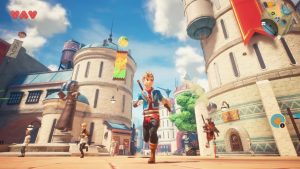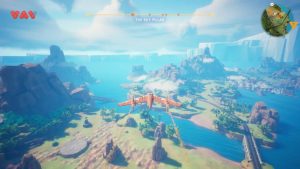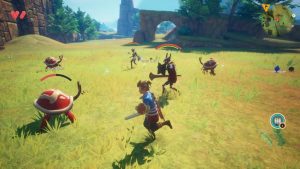Inspired By Zelda: Dive Into The Vibrant Sea of Oceanhorn 2
Posted on August 14 2021 by Joseph Berlinger

Oceanhorn 2: Knights of The Lost Realm, by Cornfox & Bros., carries a torch for Wind Waker-era Zelda just as its predecessor did.
Two years ago, we covered Oceanhorn. This 2013 action-adventure game was a detailed clone of the Zelda formula for mobile devices. Oceanhorn merged both the point-and-click sailing and island hopping of Phantom Hourglass with the more traditional control scheme of Link’s Awakening. Mechanically, the game was good for a smartphone app. Its controls were smooth and the dungeon-item progression worked as seamlessly as it does in any top-down Zelda game. While Oceanhorn‘s story was disappointingly light, it at least provided a necessary backdrop for the unnamed Hero’s adventure on the high seas.
Fast forward six years to 2019, and Cornfox & Bros. was back with a sequel. Story-wise, this new game would serve as a prequel to the original and would be set centuries in the world of Arcadia’s past. Oceanhorn 2 was ported to the Switch last year and is available on the Nintendo eShop for $22.49 USD. The following are some spoiler-free thoughts on the game’s qualities.
The Good
 This game is leaps and bounds superior to the original Oceanhorn when it comes to presentation. The isometric view has been removed in favor of a fully three-dimensional world. Now the camera follows behind the Hero in the same vein as a 3D Zelda game. The port’s graphics are both fresh and clean, especially considering its mobile game lineage. More notably, Oceanhorn 2’s lighting and shading are so vibrant that it could give Breath of the Wild‘s incredible atmosphere a run for its money. The way the sunlight wraps around the scenery looks like something out of a Pixar movie.
This game is leaps and bounds superior to the original Oceanhorn when it comes to presentation. The isometric view has been removed in favor of a fully three-dimensional world. Now the camera follows behind the Hero in the same vein as a 3D Zelda game. The port’s graphics are both fresh and clean, especially considering its mobile game lineage. More notably, Oceanhorn 2’s lighting and shading are so vibrant that it could give Breath of the Wild‘s incredible atmosphere a run for its money. The way the sunlight wraps around the scenery looks like something out of a Pixar movie.
Like its predecessor, the gameplay in Oceanhorn 2 pays homage to the Zelda franchise. While there are new items and quirks, the game carries many familiar elements and themes. For example, there are pots to smash, heart pieces to collect, macguffin emblems to pick up, and an ocean that brings out my nostalgia for The Wind Waker. The player’s Hero, who sports a familiar blue shirt and brown hair, engages his foes with a trusty blade and old-fashioned firearm. This gun uses a variety of elemental munitions to defeat enemies and solve environmental puzzles. And unlike most Zelda clones, there is also a Hookshot equivalent to get in some vertical exploration.
 When Breath of the Wild introduced motorcycles, Sheikah technology, and a literal iPad into the world of Hyrule, I pondered a question: What would it be like if we had an even more futuristic Zelda game? Oceanhorn 2 is the answer. The world of Arcadia is a hybrid of medieval lifestyle and post-industrial (and sometimes futuristic) technologies. It is unlike any game I have played before. Being a knight in a world succumbing to more and more advanced machinery feels delightfully anachronistic. Arcadia is also not small. Like Link in The Wind Waker, our Hero has a ship to sail about the kingdom. This time, instead of a one-person canoe, the player gets a reasonably-sized trawler for carrying a crew. Personally, I enjoy nautical adventures on the high seas, but for those who think sailing is tedious, there is a new method of travel. Fly though the Arcadian skies in the cockpit of a jet plane! It is cool to be given this choice to see the land from an overhead view. And extra forms of fast travel tend to exist more in JRPGs than in the Zelda franchise.
When Breath of the Wild introduced motorcycles, Sheikah technology, and a literal iPad into the world of Hyrule, I pondered a question: What would it be like if we had an even more futuristic Zelda game? Oceanhorn 2 is the answer. The world of Arcadia is a hybrid of medieval lifestyle and post-industrial (and sometimes futuristic) technologies. It is unlike any game I have played before. Being a knight in a world succumbing to more and more advanced machinery feels delightfully anachronistic. Arcadia is also not small. Like Link in The Wind Waker, our Hero has a ship to sail about the kingdom. This time, instead of a one-person canoe, the player gets a reasonably-sized trawler for carrying a crew. Personally, I enjoy nautical adventures on the high seas, but for those who think sailing is tedious, there is a new method of travel. Fly though the Arcadian skies in the cockpit of a jet plane! It is cool to be given this choice to see the land from an overhead view. And extra forms of fast travel tend to exist more in JRPGs than in the Zelda franchise.
 In the Zelda games, Link is often joined by a companion. These helpful (or in the case of Ezlo and Midna, grating) characters serve as a source of guidance and fellowship. Their presence keeps the games from feeling too isolated and lonely. It is my belief that Breath of the Wild intentionally omitted any sort of traveling companion to impress upon the player how desolate the destroyed Hyrule had become. Oceanhorn 2 reverses this decision by joining the Hero with a set of partners. As the story progresses, these allies join you on your quest. This is useful, as they handle most of the talking to other NPCs due to the Hero’s mute nature. This pair of warriors assist the player in solving puzzles across the overworld. If directed, they can also do battle against the forces of evil. By using a radial menu, the player can give orders for the companions to follow, increasing their tactical application. It is easy to get attached to them as well. They receive the majority of character development across the game, while the silent protagonist remains a mostly blank canvas. The voice acting is competent, which is a big plus for me, as poor voice work can ruin otherwise-good games.
In the Zelda games, Link is often joined by a companion. These helpful (or in the case of Ezlo and Midna, grating) characters serve as a source of guidance and fellowship. Their presence keeps the games from feeling too isolated and lonely. It is my belief that Breath of the Wild intentionally omitted any sort of traveling companion to impress upon the player how desolate the destroyed Hyrule had become. Oceanhorn 2 reverses this decision by joining the Hero with a set of partners. As the story progresses, these allies join you on your quest. This is useful, as they handle most of the talking to other NPCs due to the Hero’s mute nature. This pair of warriors assist the player in solving puzzles across the overworld. If directed, they can also do battle against the forces of evil. By using a radial menu, the player can give orders for the companions to follow, increasing their tactical application. It is easy to get attached to them as well. They receive the majority of character development across the game, while the silent protagonist remains a mostly blank canvas. The voice acting is competent, which is a big plus for me, as poor voice work can ruin otherwise-good games.
The Bad
It would be remiss to not point out that Oceanhorn 2 does have its fair share of problems and disappointing elements. Most of these issues stem from the fact that the game was originally created for smartphones. Mobile ports often carry over the limitations of their original systems. For example, there will be the occasional stiff character animation. Sword fighting is also very basic, consisting of an attack button, dodge, and block. Combat can be bogged down by a sluggish targeting system. One can only target an enemy when blocking with a shield. Upon pressing the attack button, the target lock is lost. The lack of a lock can cause the Hero to sometimes hit the wrong enemy or swing fruitlessly. This is mildly irritating, as you will most likely wind up taking damage from the foe you were originally targeting.
The most jarring issue you will likely find is the AI for Hero’s partners. They often have to be told what to do using a radial menu. This is fine during puzzle solving, but it can ruin the flow of combat. In most games, allied NPCs will attack nearby enemies automatically. But, in Oceanhorn 2, if you want your allies to assist you in battle, the AIs must be ordered to fight. As you might imagine, this gets old after a while. Sometimes its quicker to tank a little damage and finish off the foes without their help.
It would also be fair to say that the story of Oceanhorn 2 is bog standard. It is not terrible by any means, but could better be described as serviceable yet shallow. There are some conversations among your partners that smack of poor writing. While the voice acting is competent, the words spoken sometimes feel off or weighted with exposition dumps. Thankfully these faults don’t completely drag the game down.
Verdict
Oceanhorn 2 is not a perfect game. Its origins as a smartphone game do hold it back on occasion. That being said, I think its good elements outweigh the bad. Arcadia is an impressive and beautiful world to explore. The hybrid time period of fantasy and technology is distinct and enjoyable. I think the best thing about Oceanhorn 2 is that it keeps up enough quality that even its worst elements can go under the label of at least serviceable. For example, the combat problems described earlier are relieved by encounters that are balanced to be on the easier side. I do wish battles had a bit more depth, but again the game minimizes that weakness. The Hero’s special gun allows the player to take advantage of environmental factors and give some creative options during fights.
And so, not all aspects of a game need be perfect for it to be enjoyed. If you are looking for a game that merges classic Zelda gameplay with some new twists, this budget eShop title might just fit the bill.
Joseph Berlinger is a writer for Zelda Dungeon. He enjoys history, video games, books and plays the mountain dulcimer.



